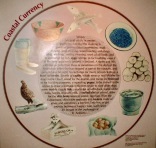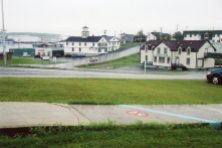
Sunday, July 24: Port Au Choix, St. Barbe and St. Anthony
Port aux Choix
From Rocky Harbour the drive north to St. Anthony is 347 km., north along the west coast. Our first stop was to visit the Port au Choix National Historic Site. Different again, informative (there is an excellent interpretive centre with many fascinating historic displays, letters and artefacts) and, yes, it’s drop dead gorgeous. We were feeling so uniquely isolated that we decided to try and phone our eldest daughter at our home in Ontario. Success! So cool! Kindly ignore the flip phone…
St. Barbe Ferry Port
We also went off the main road to grab a bite and check out St. Barbe, a little further north, where one takes the ferry to Blanc-Sablon, Labrador.
St. Anthony
Then we drove on to St. Anthony and visited the Sir Wilfred Grenfell Interpretation Centre, dedicated to St. Anthony’s truly great medical missionary, who graduated in Medicine in London, England in 1888 and four years later volunteered to come to Newfoundland. He was recruited by The Royal National Mission to Deep Sea Fishermen (RNMDSF) to care for the fishermen and communities here. Grenfell’s work expanded to include helping the indigenous peoples of Newfoundland and Labrador. He sometimes traveled in a hospital ship to serve the huge, diverse and far-flung community. By 1914 his mission was world famous and a charitable society, the International Grenfell Association, was formed because of influence from a group of New York businessmen who wished to advance his work. A concise description of the history of Grenfell’s life and of both the RNMDSF and IGF, is given at the above IGF link. Both the British Mission, serving 70 UK ports, and the St. Anthony-based IGF are still going today!
We stayed at the Haven Inn in St. Anthony for two nights. On Monday we planned to visit the Viking Settlement at L’Anse aux Meadows.
Now, there’s a screwed up franglais name for a ninth century Nordic village! So typically Canadian.
Sorry…











